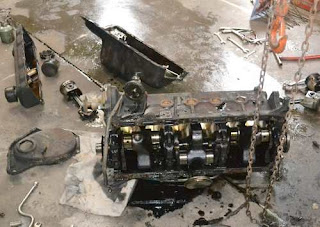Oil the rings on the pistons thoroughly and use a ring compressor to get the pistons in the correct way. They should be put in with arrows facing a particular direction, from memory, and will probably be numbered, too. The numbers are less important, but if they're there use them.
Insert new crank shaft bearings and attach. Torque to the correct setting. If you need any of this info, just ask me or Google it, as I'm sure it'd be freely available.
If you have removed the timing case like I did, you will need to align the marks on the pulleys prior to putting the timing chain back on. This is really important: My Dad didn't get it right and it was out by 1 cog. Result was the car had no power and we had to remove the engine again to do it right!
Put the timing case back on with the sump (see below). The engine should be on TDC now.
Put the head back on and torque it up. The engine guy said that even monotorque gaskets should be re-torqued. Schedule this now. If you can't do this because it keeps moving make a note for yourself to do it as soon as the engine is back in the car. If you're a bit absent-minded, put a sticky note over the ignition to remind you.
Lift the engine up with your lifter (or block and tackle) now and put the sump/timing cover on.
The sump should be cleaned and a new gasket with lots of gasket goo will ensure you won't have any dramas with leaks. Use the torque settings again for everything. An oil leak will spoil your pleasure at the end of this and it's extremely difficult to tighten sump bolts with the engine in.
Prior to engine installation I also painted the engine. Couldn't get Chrysler engine blue so did it Ford blue. In retrospect I shouldn't have done this. The paint place in Preston (at the forking of Plenty Road) had the stuff, but I didn't know this.
Putting the engine in was the reverse of removal, with particular attention paid to the alternator and distributor. Torque the head if you couldn't before.
Make sure the distributor goes in with the rotor facing #1. If you didn't mess with the valve timing this should go back in easily and look like the photo you took beforehand. You also should not have to do with the valve clearances if you put the rods back in the same holes, unless you needed to do them anyway. If you do, start the car, warm it up, turn it off, remove the rocker cover, Turn it back on and do it while the engine's going. This is a lot easier and quicker than doing it by turning the engine over by hand.
If you want to (I didn't) you can re-check the compression to make sure it matches that in the book, and that it's consistent between cylinders. The Valiant now runs like it should. It idles much better and is better on fuel (although fuel economy still rubbish on gas for some reason).
Here are some photos of the reassembly.
|









